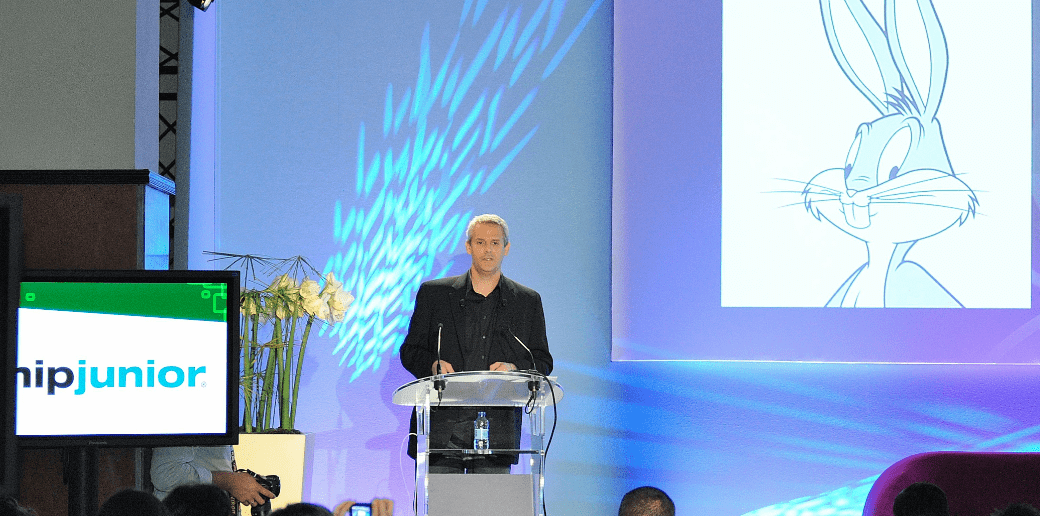As executive vice president for creative affairs at Warner Bros. Animation, Sam Register is overseeing a host of familiar animated brands, from Looney Tunes to DC Nation. He gave the Mastermind Keynote speech to close MIPJunior today, sharing details of what the studio is up to, and how it sees the industry.
“I wanted this to be educational and not just plug Warner Bros,” he explained. The company has been around since 1933, when it started producing Looney Tunes and Merrie Melodies, and remains a working studio. It also oversees libraries for Warner Bros’ own content, Hanna Barbera, MGM and DC.
“This library is very important to Warner Bros. because it’s why we exist,” he said. “We do not necessarily have a network. We have to pitch to Cartoon Network like everybody else, and it’s not guaranteed that we’ll get our shows on the air. What does get our shows on the air are these characters.”
Currently, Warner Bros. makes a mixture of TV shows, direct-to-video films, and theatrical shorts. “Currently we have nothing in the pipeline that is original,” he said. “We are not taking any pitches, because we are busy. I get a lot of calls to meet or see new properties. I can’t. Stuffed with content!”
However, he warned that there is a danger that WB’s classic characters will age and stop being relevant: it’s Register’s job to ensure that doesn’t happen, by keeping the characters going.
How? Register talked about three specific examples: Looney Tunes, ThunderCats and Green Lantern. “We ask two questions of ourselves on every property,” explained Register – those being ‘What is core?’ and ‘What can change?’. “If I just try to make what was core the first time, I will fail. If I just try to make Looney Tunes as good as they once were, I will fail… That ship has sailed.”
Warner Bros. starts every new project by finding a creative showrunner/producer who is passionate about the property. “I cannot do anything good unless this guy or girl is good too,” he said. “They need to love the property. They need to care about it as much as I do. It’s better if they care more about it… And I love it if they argue with me.”
Register talked about a point in the not-so-distant past when the Looney Tunes were losing their relevance, which led to Warner Bros. working on The Looney Tunes Show, which he described as a “long and difficult process… I went over budget!”
What was core about the Looney Tunes? The iconic characters, smart and funny dialogue, physical humour – “People got hit on the head with anvils. It’s very important” – music and the voices. What changed? The character designs for starters: Bugs Bunny was drawn a different way.
The format was also changed: the original Looney Tunes shows were seven minutes each, but the new version were 22 minutes, and more of a sitcom feel. Character relationships also changed: Bugs Bunny and Tweetie Pie had never met in the original shows, but that changed in the new version. Meanwhile, a music video was added to every episode, and the settings were changed.
Onto ThunderCats, which Register described as “probably the last great 80s property” that hasn’t been revived. Warner Bros. created a new Thunder Cats, which has been well received. “And more importantly, the toys are selling like crazy.”
What was core? The original team, the hero’s journey, and the blend of swords and science. The original theme song was very important to fans. “We wanted to keep the song. I paid a lot of money to get the song,” he noted dryly.
What changed? The mythology was updated. “They were cats from a planet, and they were naked then they got clothes on… We decided to throw it out. Nobody cares. Well, seven people on the internet care…” Meanwhile, the characters were more layered, and Warner Bros. adopted an anime production style. There were real stakes this time round too: characters die.
The third case study was Green Lantern, who was the subject of a blockbuster film, and thus got a separate animated series for TV, which was Warner Bros’ first computer-generated TV show. Core features: the Green Lantern’s “loveable rogue” character, his comic-book mythology, and the fact that he was a solo hero.
However, the CG aspect was a key change. “I had to go in and pray, and get on my hands and knees and pray to men in ties at Warner Bros. to get the money to do this.” The series had a new storyline, and had a ‘buddy’ aspect added – a companion character.
Meanwhile, Register also talked about Warner Bros. Animation starting to create theatrical shorts to be shown before Warner Bros. films. Its Road Runner short was nominated for an Oscar, and now it’s working on a stereoscopic 3D Tweetie Pie short, and another with Daffy Duck.
“Mel Blanc, the original voice of these characters, did kids’ records in the 1930s… We pulled those tracks off the records and created new cartoons,” said Register, citing it as an example of something core and also something new.
Meanwhile, Warner Bros. is also working with DC Comics and Cartoon Network on something called DC Nation: a three-year deal for an hour-long block of TV blending episodes of action shows, shorts and interstitials. “Every week on Cartoon Network you will see something new,” said Register. That includes a partnership with Aardman Animation, which is making claymation Batman shorts.
For the future, Warner Bros. is working on Beware The Batman, a CG series due to make its debut in 2013, pulling out more villains from his back catalogue: “We didn’t want to do another Joker story,” said Register. Alfred the butler gets a gun.
Also in development is The Tom and Jerry Show, which Register said will hopefully be on air in late 2012. However, Warner Bros. is also working on a slate of animation for adult cable networks.
Register said his team does not get directly involved in opportunities on other platforms around its remakes, like apps, games and virtual worlds. Instead, they work with other parts of Warner Bros. responsible for those areas. “We make the animation – we make it as good as we can – and hopefully games and comic books and toys will come from that,” he said.





5 Comments
Pingback: Do You Think Internationally When Developing A Series? | The Animation Anomaly
Pingback: Hey, Answerman! We Can’t Have Nice Things - DOCUMENTS – DOCUMENTS
Pingback: UTILITY DOCUMENT » Hey, Answerman! We Can’t Have Nice Things » UTILITY DOCUMENT
Pingback: Sam Register @ MIP Jr: "Beware the Batman"; "Super Best Friends Forever"; "Tom & Jerry"; "DC Nation" News
Pingback: Aardman Tackles Batman and WB Animation’s Moribund State | I am on the Line